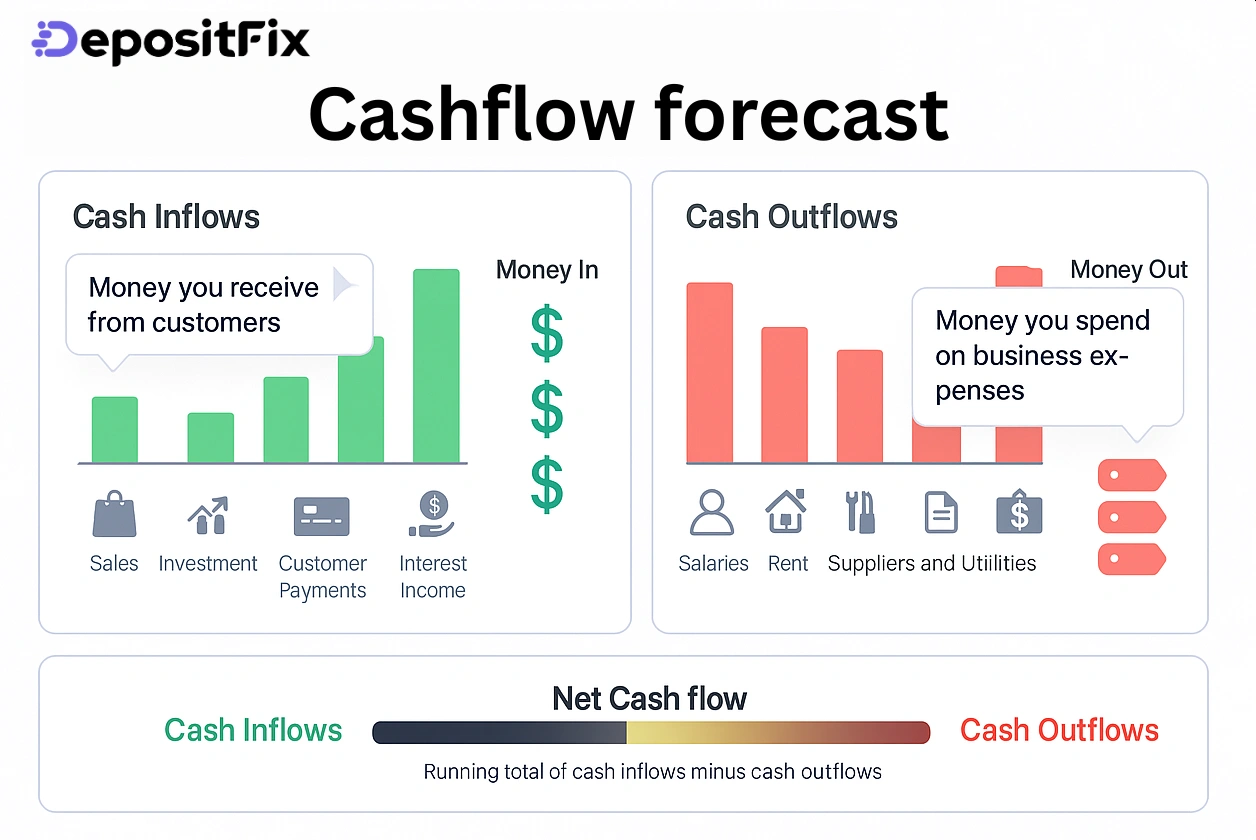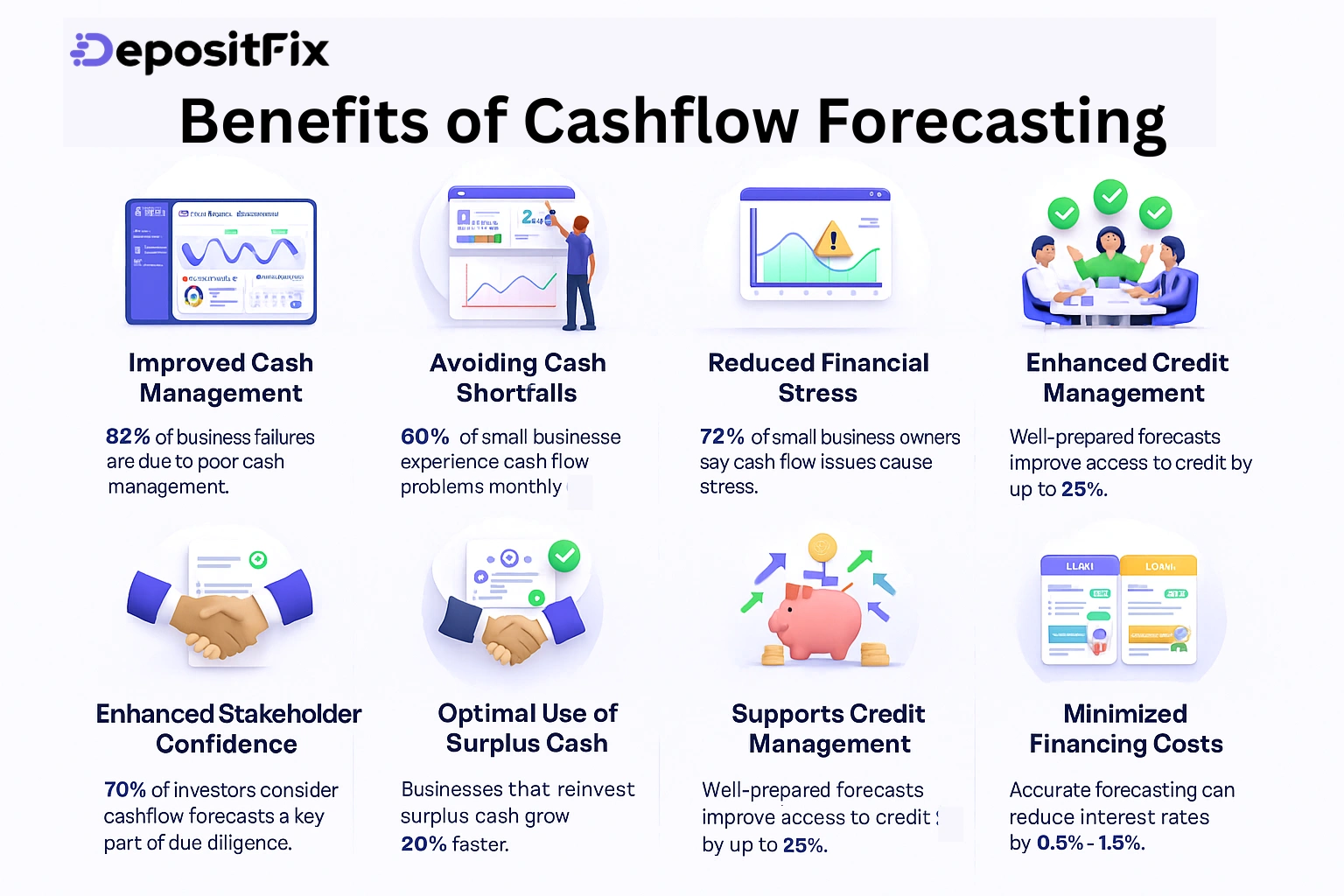Cashflow forecasting is a tool that helps businesses predict the flow of cash in and out of their accounts over a specific period. When businesses estimate future income and expenses, they can ensure they have enough liquidity to meet obligations, avoid cash shortages, and make informed strategic decisions.
Cashflow forecasting is about predicting future cash movements. It helps businesses understand their financial health. Look at past data to spot cash issues early. This lets you make smart choices for financial stability.
Finance teams collect important data to make forecasts. They use invoices, sales records, and payroll. It's important to consider both regular and unexpected changes in cash flow.
Using treasury and risk management systems can make forecasting better. These systems update forecasts in real-time. This helps you manage cash more effectively and improves your financial planning.
Cashflow forecasting is important because it helps businesses maintain financial stability and avoid unexpected cash shortages. When companies predict when money will come in and go out, they can plan ahead, make smarter investment decisions, and ensure they have enough funds to cover expenses like payroll, rent, and inventory.
It also supports better budgeting, highlights potential financial risks early, and builds confidence among investors and stakeholders. Ultimately, effective cashflow forecasting helps businesses stay in control of their finances and grow sustainably.
The objectives of cashflow forecasting are to ensure sufficient liquidity, support strategic planning, anticipate cash shortages or surpluses, and improve financial decision-making.
The main goal is to keep enough cash on hand. It lets you track money coming in and going out. This way, you can always meet your immediate needs without trouble.
Spot cash shortfalls early. Regular forecasting helps you see when you might run low. Then, you can fix the problem before it hurts your business.
Good cashflow forecasting helps make smart choices. It gives you a clear view of your finances. This helps you decide on investments and plan for new projects.
Forecasting shows you where you stand financially. This lets you use your resources wisely and grab new chances for growth.
Keeping a close eye on cash helps you control your finances better. Regularly checking cashflow helps you make smart spending and investment choices. This careful planning helps you use resources wisely, improving your cash situation.
Being open and accurate with financial reports builds trust with stakeholders. Showing them your cash situation clearly shows you're stable and reliable. This trust strengthens relationships and encourages more partnerships.
Managing working capital well is important for your business's survival. Watching cash flow helps you use resources better, reducing waste. This approach supports your business's growth and helps it stay strong in changing markets.
Having a strong financial position helps you get better financing deals. Good cashflow forecasting shows your business's health, leading to better loan terms or investor interest. This reduces the costs of borrowing.
The components of a cashflow forecast include cash inflows, cash outflows, opening balance, and closing balance, all of which help track and predict a business’s financial position.
Cash inflows are the money your business gets. This includes sales, investments, and other income. Knowing these inflows helps keep your cash flow positive and supports growth.
Cash outflows are the money your business spends. This includes salaries, rent, and loan payments. Understanding these helps you plan for financial challenges and use resources wisely.
The net cash flow is the difference between what comes in and what goes out. It shows your business's financial health. A positive net cash flow means you're doing well. A negative one might mean you need to adjust spending or make more money.

Cashflow forecasting periods refer to the specific timeframes—short-term, medium-term, or long-term—used to predict a business’s future cash inflows and outflows.
Short-term cash flow forecasting looks at your immediate financial needs. It covers from daily checks to three-month plans. You can track daily costs, predict income from sales, and spot cash shortfalls.
Having real-time data lets you make quick changes. This keeps your cash flow steady during ups and downs.
Medium-term forecasting is for three to twelve months. It lets you plan strategically. You can budget for growth, seasonal changes, or investments.
This period helps you spot cash flow trends. It makes it easier to use resources wisely.
Long-term forecasting looks at one to five years. It matches with your big business plans. You can forecast income and spending, check investment chances, and get ready for economic changes.
Knowing your long-term cash flow helps you make confident decisions. It guides your financing and growth plans.
Cashflow forecasting methods are the approaches businesses use, such as direct or indirect forecasting, to estimate future cash movements and manage financial planning.
This method looks at real cash coming in and going out over a short time. It gives a clear picture of cash flow and shows expected money in and out. This helps in making plans and decisions. It's especially useful for checking immediate financial needs.
This method uses net income adjustments from the income statement for long-term planning. It shows the cash position and includes non-cash items. It's good for businesses wanting to see their overall financial health based on earnings.
The hybrid method mixes direct and indirect methods. It offers flexibility for different needs. It combines quick cash flow insights with long-term financial views. This suits various business situations and ensures a full cash management analysis.
Cashflow forecasting comes with many challenges. You face issues like data accuracy, unpredictable payments, and changing markets. These factors make forecasting tricky.
Using bad data is a big problem. It can lead to wrong forecasts and bad financial choices. This often happens because of old systems or poor data collection.
Customer payments can be hard to predict. This makes it tough to manage cash flow. Payments can change due to many reasons, like customer credit or the economy.
Market changes can really affect your forecasts. Things like demand shifts, new rules, or competition can change your money flow. Keep your forecasts up to date.
Businesses with many revenue sources face extra challenges. If you sell through different channels or products, it's harder to predict money coming in. You need to understand each source well.
Businesses see ups and downs in demand throughout the year. This can greatly change cash coming in, making cash management a big challenge. Knowing these patterns helps in making better forecasts and prepares for busy seasons when cash needs increase.
When financial tools don't talk to each other, it's a big problem. This can cause wrong data and inconsistent reports, making forecasting hard. To fix this, make sure all systems work together smoothly. This improves data accuracy and helps in calculating cash flow needs better.
People making mistakes is a big issue in forecasting. Manual entry and analysis can lead to errors that mess up forecasts. To lessen this, having clear processes and regular checks can help. This makes forecasts more reliable over time.
Small businesses often struggle with forecasting because of limited skills or tools. Without the right tools and training, making accurate forecasts is tough. Investing in staff training and using software for cash flow management can greatly improve forecasting skills and give better insights into cash needs.
Using cashflow forecasting brings many benefits that help your business stay financially stable. It helps you understand where money is coming in and going out. This way, you can manage your cash better and deal with financial challenges more easily.
Cashflow forecasting makes managing your cash better and gives you insights into your money flow. With good forecasts, you can use your resources wisely. This means you can pay for what you need and still have money for growth.
Another big plus of cashflow forecasting is it helps you avoid running out of cash. When you know when you might not have enough, you can plan ahead. This could mean cutting back on spending or finding extra money. It keeps your business financially stable.
Cashflow forecasting also makes your financial planning stronger. It lets you make budgets that are based on solid forecasts. This way, you can match your income with your spending. It helps your business grow in a way that's both sustainable and profitable.
Finally, cashflow forecasting reduces financial stress for you and your team. When you know you can handle your cash, you feel more confident. This creates a more stable business environment for everyone involved.
Accurate cashflow forecasts build trust with stakeholders. Investors and partners want reliable data to make smart choices. When you show solid forecasts, you prove that you can handle money well. This trust helps attract investment and support.
Good cash management means using extra money wisely. Instead of letting it sit, a forecast helps find smart ways to use it. This could be investing or paying off debts, leading to better returns or financial health.
Cashflow forecasting shows you can keep cash flowing well, making you more credible to lenders. This credibility can get you better loan terms, boosting your financial health.
Showing you're reliable through cashflow forecasting can lower financing costs. A track record of accurate forecasts builds a reputation for financial responsibility. This can get you lower interest rates and better terms, helping fund growth.

DepositFix helps remove the guesswork from forecasting. It gives you a clear view of your financial health.
DepositFix's tools automate forecasting, making it easier to predict cash flows. This financial software brings all your data together in one place. It helps you make better predictions and manage your cash more effectively.
Using DepositFix makes forecasting faster and easier. You spend less time on manual calculations. This lets you focus more on your business and less on financial worries. Start using DepositFix to improve your financial planning now.
Cashflow forecasting helps you keep money flowing, make smart choices, and grow sustainably. Knowing how to forecast helps your business handle surprises better.
Using good forecasting methods lets you predict money coming in and going out. A solid forecasting practice improves your control over money and builds trust with others, leading to success over time.
Focus on accurate cashflow forecasting to improve daily work and meet your financial goals. Adopting this practice prepares your business for a bright future.
Discover the hidden automation in your payment, billing and invoicing workflows. Talk to our experts for a free assement!
